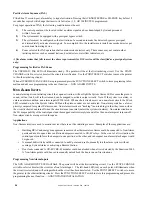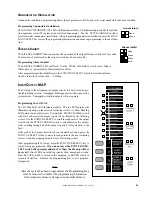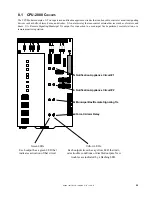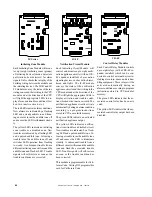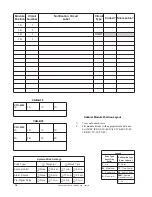
S2000 15017 Rev H 10/08/96 P/N 15017:H
67
Maximum Secondary Power Fire Alarm Current Draw
Use Table A-2B to determine the maximum current requirements of secondary power source during fire alarm conditions.
The total obtained in Table A-2B is the amount of current that the batteries must be capable of supplying. This figure will
be used in Table A-2C to determine the size of the batteries needed to support five minutes of fire alarm operation.
Table A-2B assumes that while in a fire alarm condition, the batteries must feed the main power supply and any additional
supplies (AVPS-24F/AVPS-24FE) with the maximum rated power each supply can provide.
Note:
Due to the maximum
rating of 9 amps imposed when using PS-12250 batteries, it may be necessary to calculate the exact requirements of the
secondary supply. In that case, add the Secondary Non-Fire Alarm Load obtained in Table A-2A to the total fire alarm
current draw of all Notification Appliances in the system and substitute that figure in Table A-2B for the main power supply
and any additional supplies.
Notes:
1. NFPA 72-1993 Local, Central Station, and Proprietary Fire Alarm Systems require 24 hours of standby power followed by five
minutes in alarm. NFPA 72-1993 Auxiliary and Remote Station Fire Alarm Systems require 60 hours of standby power followed by
five minutes in alarm. Batteries installed in a system powered by a generator need to provide at least four hours of standby power.
2. If the total exceeds 55AH (17AH on the MPS-24BF), a UL-listed Uninterruptable Power Supply (UPS) with sufficient capacity is
needed. If the system does not have battery backup, a UPS must be installed in the same room as the FACP.
Table A-2C: Secondary Power Standby and Fire Alarm Load
Table A-2B: Maximum Secondary Power Fire Alarm Current Draw
e
c
i
v
e
D
e
p
y
T
r
e
b
m
u
N
l
e
d
o
M
f
o
#
s
e
c
i
v
e
D
t
n
e
r
r
u
C
)
s
p
m
a
(
l
a
t
o
T
t
n
e
r
r
u
C
r
e
w
o
P
:
s
e
il
p
p
u
S
E
F
A
4
2
-
S
P
M
/
F
A
4
2
-
S
P
M
r
o
E
F
B
4
2
-
S
P
M
/
F
B
4
2
-
S
P
M
1
X
0
.
6
r
o
3
9
.
2
=
E
F
4
2
-
S
P
V
A
/
F
4
2
-
S
P
V
A
[
]
X
0
.
3
=
d
a
o
L
m
r
a
l
A
y
r
a
d
n
o
c
e
S
r
o
f
n
m
u
l
o
C
m
u
S
=
s
p
m
a
e
ri
F
-
n
o
N
y
r
a
d
n
o
c
e
S
d
ri
h
t
m
o
rf
(
d
a
o
L
m
r
a
l
A
)
A
2
-
A
e
l
b
a
T
,
n
m
u
l
o
c
X
-
n
o
N
y
r
a
d
n
o
c
e
S
d
e
ri
u
q
e
R
e
m
i
T
y
b
d
n
a
t
S
m
r
a
l
A
e
ri
F
)
s
r
u
o
h
0
6
r
o
4
2
(
=
m
r
a
l
A
e
ri
F
-
n
o
N
y
r
a
d
n
o
c
e
S
p
m
A
y
b
d
n
a
t
S
s
r
u
o
H
m
r
a
l
A
e
ri
F
y
r
a
d
n
o
c
e
S
d
a
o
L
)
B
2
-
A
e
l
b
a
T
m
o
rf
(
X
e
m
i
T
m
r
a
l
A
e
ri
F
d
e
ri
u
q
e
R
,
4
8
0
.
0
r
e
t
n
e
,
s
e
t
u
n
i
m
5
r
o
F
(
)
5
2
.
0
r
e
t
n
e
,
s
e
t
u
n
i
m
5
1
r
o
f
=
e
ri
F
y
r
a
d
n
o
c
e
S
r
u
o
H
p
m
A
m
r
a
l
A
t
n
e
m
e
ri
u
q
e
R
s
r
u
o
H
e
r
e
p
m
A
y
r
a
d
n
o
c
e
S
l
a
t
o
T
r
o
f
n
m
u
l
o
C
m
u
S
=
d
e
t
a
l
u
c
l
a
c
=
2
.
1
X
r
o
t
c
a
f
g
n
it
a
r
e
d
e
h
t
y
b
y
l
p
it
l
u
M
d
e
ri
u
q
e
R
s
r
u
o
H
e
r
e
p
m
A
y
r
a
d
n
o
c
e
S
l
a
t
o
T
s
p
m
a


